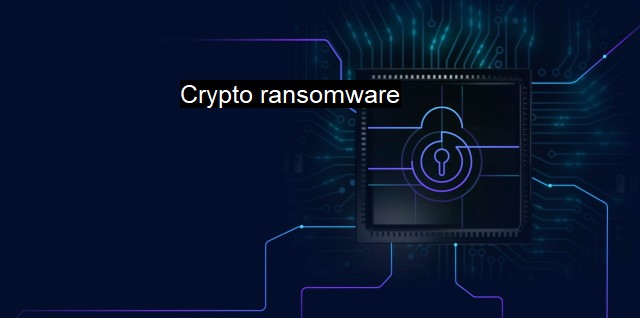What is Crypto ransomware?
Understanding Crypto Ransomware: The Danger and Impact on Businesses and Individuals Worldwide
Crypto ransomware is a form of malicious software (malware) sweeping over the digital landscape, presenting grave challenges for individuals and businesses alike. The evolution of technology and the internet brings forth a multitude of advancements. Still, in parallel, it also ushers potentially destructive features of the cyber world. Crypto ransomware stands at the epicenter of such threats.Understanding crypto ransomware is of paramount importance. crypto ransomware is a type of ransomware that employs cryptography to hold the victim's data or system captive. The attacker encrypts the user's files or data, making them inaccessible without a decryption key, which the attacker holds. The perpetrator then demands a ransom, generally in the form of cryptocurrency given its anonymity, to release the decryption key. Without the key, the user essentially loses access to the infected files, often leading to significant negative implications given our current reliance on digital data storage.
Remote hacking capacities, combined with the decryptable permanence of files under ransom, render crypto ransomware dangerously efficient. The effects vary, accumulating from general inconvenience to potential business operation halt and significant financial losses.
Crypto ransomware accentuates a dire need for robust antivirus software and effective cybersecurity strategies. Such strategies should encompass three critical fronts – prevention, mitigation, and recovery. Prevention involves encasing data and systems in multiple layers of security, strengthening them against germinating attacks. Regular system and security updates, strong password protocols, secure network use, routine backups, and employee cybersecurity training constitute preventative measures.
On the other hand, the mitigation element focuses on defusing an ongoing attack in real-time, diminishing its harmful effects. This stage implicates defensive technologies and sophisticated software capable of detecting and neutralizing invading malware. Antivirus programs fall here, specializing in identifying malware signatures and eliminating potential threats. State-of-the-art antivirus programs can detect tell-tale signs of crypto ransomware attacks – usually abrupt surge in file encryption – and counter them.
The recovery phase constitutes one of the hardest aspects of crypto ransomware management. Retrieving encrypted information without giving in to attackers' demands might be somewhat implausible given the strong encryption technologies commonly employed and the fact that the attacker typically holds the only decryption key. Hence, incident response teams often focus on alternative procedures such as isolating and cleaning infected systems, restoring functions through backups, or industry-specific decryption tools.
The part played by quality antivirus software and cybersecurity strategies in thwarting crypto ransomware attacks can't be overstated. Complete security not only involves a rock-solid protective façade but also thorough interior safety mechanisms. This multi-pronged approach rings true for crypto ransomware as well. To abate this ever-escalating challenge, implementation of intelligent antivirus defenses, adept at countering complex ransomware architecture, is pressing.
Antivirus programs now employ mechanisms such as behavioral detection, sandboxing, and artificial intelligence to isolate and eliminate threats before they infiltrate systems. These are coupled with real-time protection features that constantly monitor for suspicious activity, offering an added layer of defense against crypto ransomware.
That said, technology alone cannot tackle this issue. Accounting for the human factor in cybersecurity measures is equally critical, given that many crypto ransomware attacks capitalize on human error or political decisions. Consequently, fostering a security-aware culture becomes integral in surviving within this digital era manned with crypto ransomware and similar threats.
Crypto ransomware represents tangible destructive capacity within the cyber world, harnessing innocent users' data as bait for ransom. Its presence emphasizes the invaluable role of effective antivirus programs as well as comprehensive cybersecurity strategies. As digital terrains amplify, the fight against crypto ransomware persists, reminding us always to be prepared and armed.

Crypto ransomware FAQs
What is crypto ransomware?
Crypto ransomware is a type of malware that encrypts files on a victim's computer or network, making them inaccessible until a ransom is paid.How does crypto ransomware infect a computer?
Crypto ransomware can infect a computer through various means, such as phishing emails, malicious downloads, or exploiting vulnerabilities in software.What are some best practices to protect against crypto ransomware?
Some best practices to protect against crypto ransomware include regularly backing up files, using antivirus software, keeping software updated with the latest security patches, and avoiding suspicious emails or downloads.Should I pay the ransom demanded by crypto ransomware?
It is generally not recommended to pay the ransom demanded by crypto ransomware, as there is no guarantee that the attacker will provide the decryption key or that the files will be recovered. Additionally, paying the ransom encourages attackers to continue their malicious activities.| | A | | | B | | | C | | | D | | | E | | | F | | | G | | | H | | | I | | | J | | | K | | | L | | | M | |
| | N | | | O | | | P | | | Q | | | R | | | S | | | T | | | U | | | V | | | W | | | X | | | Y | | | Z | |
| | 1 | | | 2 | | | 3 | | | 4 | | | 7 | | | 8 | | |||||||